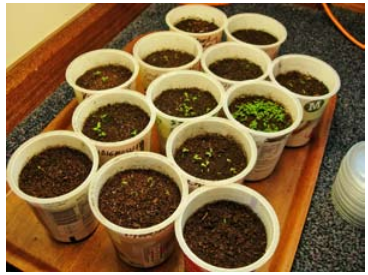I write this article with some trepidation because many readers are skilled propagators. This is not for them. It is also not advice on good practice, it is just a record of my efforts. It is written with the hope that readers that haven’t tried propagating rhododendrons will buy seed from the seed exchange and grow their own plants. I always
feel there is some thing special about the plants we have propagated ourselves.
“I must thank Willie Campbell for managing the seed exchange and Alan Anderson, Alan Clark and Peter Cox for supplying the seeds I ordered. These people and others use great skill to prepare seeds and then generously donate them to the SRS seed exchange for the rest of us to use. Without them I wouldn’t be able to write this.”
I started to take an interest in species rhododendrons in 2014 and having some experience at propagating easy to grow shrubs I thought rhododendrons should be no problem. Well for me so far it has been a mixture of luck followed by some failures but once I started taking more care I am very pleased with my success rate. I started by picking an old open seed pod in early summer 2014 from what I thought was R. thomsonii. I read that old pods usually still had some seed left in them. I crushed the pod to get some seed out of it and spread all of it, seeds and bits of seed pod on to a pot of used ericaceous compost then put it out in the sun on the south side of my garage where it was occasionally watered. I had in my ignorance done all the wrong things but I was rewarded with a pot of seedlings. I will grow some on to see what they turn out to be. After my initial success I started to read articles on the internet that suggested it is not that easy. I suggest you look at http://www.rhodoland.nl and click on the English version. I was interested in his notes on propagation. This is a site written by a very enthusiastic hybridiser in the Netherlands. I just love his enthusiasm.


I joined the SRS in November 2014 and bought seed from the seed exchange. I couldn’t get peat locally so I used commercial ericaceous compost and sowed my seeds in trays on a north facing window sill and covered them with cling film. This didn’t work very well. I lost most of the seedlings due to being too wet and the compost grew a great crop of moulds and fungi.
With fresh seed from the seed exchange I started again on 19th of March 2016. I used 50/50 peat and perlite and put a thin layer of finely sieved peat on the surface of the compost. After soaking the trays in ericaceous liquid fertiliser mixed at half the strength for foliar feeding, I sowed 12 different species of rhododendrons very thinly, then placed them in a heated propagator in my green house. Just in case the propagator got cooking in the sun, I also sowed a second lot of seed in pots with transparent lids. These were grown in my house. I used a 30W CFL (energy saving) lamp 450mm above these when they started to germinate. The seedlings grown indoors did just as well as those in the green house. Most of the seed had germinated in about 3 weeks. As the seedlings grew many of them had roots on the surface of the compost so I sprinkled fine peat over them to cover the roots and help to support them. In some cases the seedlings fell over so these were replanted and supported with peat raked around them using a bit of wire.
By mid April I was getting worried about controlling the light levels and temperatures in the propagator. Greenhouse shading wasn’t enough and some days I was a bit late getting newspaper covers on the propagator so I moved them all into my house and used a 600mm long double fluorescent light about 700mm above them. This solved the problem and the seedlings grew on well. By the 16 June 2016 I started transplanted some very small seedlings to about 1½ inches apart into trays again with peat and perlite mix, Some were almost too small to handle but had good roots. I transplanted them early because green slime was growing on the surface. The slime was because I had been so worried about the compost drying out that I had been spraying the surface every time it looked a bit dry. I found it difficult to get the watering right. It just takes a blink of sunshine and the surface dries out even though the green house was well shaded on the roof and two layers of 40% shade cloth on the sides.
” Finding the balance between compost being too dry and having a layer of green slime is tricky”

rooted cuttings planted out and
this years seedlings in trays
By the 22 June it had become too much hassle for me to be constantly covering seedlings in the green house with newspaper when the sun comes out and then removing them when the clouds move in. The thought that I might not get the covers on quick enough one day and I could lose the lot. So I moved most of the seedlings outside to an alcove on the north side of the house where they couldn’t get any direct sun. In July I put them all into a shade cage I had just built and they are doing well, all I have to do is keep the slugs away.
At this stage I realised trying to achieve the text book “bright situation but no direct sun light” is a bit optimistic and it took a while for me to realise that light from the north is sufficient for rhododendron seedlings to grow.
